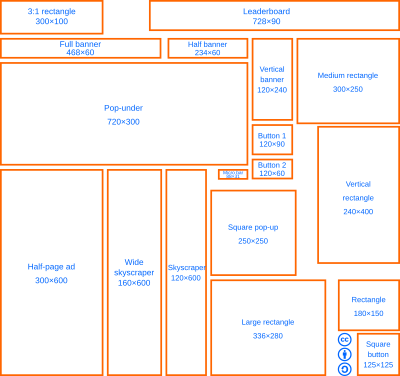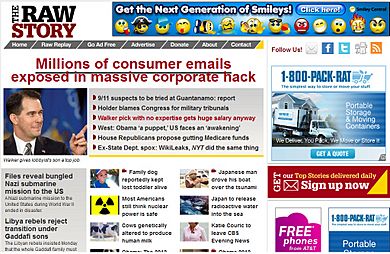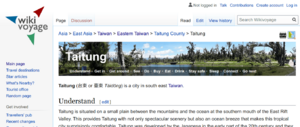Web banner facts for kids
A web banner or banner ad is a type of advertisement you see on the World Wide Web. Think of it like a digital billboard on a website. These ads are placed on web pages to get your attention. Their main goal is to make you click on them. When you click, they take you to the advertiser's website.
Often, special systems called ad servers deliver these banners. This helps websites earn money to provide their content for free. Advertisers also use ad networks to place their ads. This helps them reach the right people.
Web banners work much like old-fashioned ads. They tell you about a product or service. They also give reasons why you might want to choose it. What's cool about web banners is that companies can track how well they work in real-time. They can also show ads based on what you like. This tracking often uses something called a click tag.
Some people find these ads annoying. They can distract from what you want to read. They might also use up your internet data. Sometimes, banners even cover parts of the screen you want to see. Many newer web browsers have tools called "adblockers." These tools can stop pop-up ads or block images from certain websites. You can also use a proxy server like Privoxy to block them. Browser extensions like Adblock Plus for Mozilla Firefox or AdThwart for Google Chrome can also help.
The Story of Web Banners
Web banners were very important for making online advertising popular. They helped the internet grow quickly.
The first company to use online ads was Prodigy. This company was owned by IBM and Sears back in the 1980s. Prodigy first used ads to sell Sears products. Later, they showed ads for other companies, even for their competitor, AOL. But Prodigy didn't fully use its early start in online advertising.
The very first clickable web ad appeared in 1993. It was sold by Global Network Navigator (GNN). The ad was for a law firm called Heller, Ehrman, White, & McAuliffe. GNN was one of the first websites to be supported by ads.
For a long time, many thought HotWired invented the digital banner ad. HotWired was one of the first websites to sell many banner ads to big companies. Rick Boyce led the sales team for HotWired. HotWired even came up with the name "banner ad." They were also the first to tell customers how many people clicked on their ads. The first web banner sold by HotWired was for AT&T Corp.. It went online on October 27, 1994. Another story says the first ad was for Coors' "Zima" in October 1994.
However, Time Warner's Pathfinder (website) also launched with banner ads. This was on October 24, 1994, just three days before HotWired. Walter Isaacson and the Columbia Journalism Review say that Bruce Judson invented the idea of the banner ad. Isaacson said that Judson's idea changed everything. Advertising companies quickly wanted to learn about online ads. They sent a lot of money to buy banner ads.
In July 1995, Focalink Communications released the first central ad server. This made it easier to manage and track online ads. NetGravity then released a local ad server in January 1996. These new technologies helped web advertising grow a lot from 1994 to 2000. Later, companies like GoTo.com (which became Overture and then Yahoo!) and Google's AdWords changed things. They focused more on tracking how people responded to ads, not just how many times they were seen.
Standard Sizes for Banners

Ad sizes have become more standard thanks to the IAB. Before the IAB, there were over 250 different banner ad sizes! Now, things are much more organized. Still, some websites or ad networks outside of Europe or North America might use different sizes.
Here are some of the standard ad sizes from the IAB:
| Name | Width / px | Height / px | Aspect ratio |
|---|---|---|---|
| Rectangles and Pop-Ups | |||
| Medium Rectangle | 300 | 250 | 6∶5 |
| Square Pop-Up† | 250 | 250 | 1∶1 |
| Vertical Rectangle† | 240 | 400 | 3∶5 |
| Large Rectangle† | 336 | 280 | 6∶5 |
| Rectangle | 180 | 150 | 6∶5 |
| 3:1 Rectangle† | 300 | 100 | 3∶1 |
| Pop-Under† | 720 | 300 | 2.35∶1 |
| Banners and Buttons | |||
| Full banner† | 468 | 60 | 78∶10 |
| Half banner† | 234 | 60 | 39∶10 |
| Micro button | 88 | 31 | 88∶31 |
| Button 1† | 120 | 90 | 4∶3 |
| Button 2 | 120 | 60 | 2∶1 |
| Vertical banner† | 120 | 240 | 1∶2 |
| Square button† | 125 | 125 | 1∶1 |
| Leaderboard | 728 | 90 | 728∶90 |
| Skyscrapers | |||
| Wide skyscraper | 160 | 600 | 4∶15 |
| Skyscraper† | 120 | 600 | 1∶5 |
| Half page ad | 300 | 600 | 1∶2 |
Notes
In 2015, the IAB updated its rules for ads on screens and mobile devices. They started using HTML5 for these ads.
In 2017, the IAB added new rules. These included flexible ad formats. They also covered new digital experiences. This included things like augmented reality (AR) and virtual reality (VR). Social media, mobile video, emoji ads, and 360-degree video ads were also part of the new rules.
| Ad Unit Name | Size (px) | Aspect ratio | Pixels | |||
|---|---|---|---|---|---|---|
| Billboard | 970 | × | 250 | 97:25 | 242,500 | |
| Smartphone Banner | 300 | × | 50 | 6∶1 | 15,000 | |
| Smartphone Banner | 320 | × | 50 | 32:5 | 16,000 | |
| Leaderboard | 728 | × | 90 | 728∶90 | 65,520 | |
| Super Leaderboard/Pushdown | 970 | × | 90 | 97:9 | 87,300 | |
| Portrait | 3: | 300 | × | 1050 | 2:7 | 315,000 |
| Skyscraper | 160 | × | 600 | 4:15 | 96,000 | |
| Medium Rectangle | 300 | × | 250 | 6∶5 | 75,000 | |
| — | 120 | × | 160 | 3:4 | 19,200 | |
| Mobile Phone Interstitial | S: | 640 | × | 1136 | ≈9:16 | 727,040 |
| Mobile Phone Interstitial | M: | 750 | × | 1334 | 9:16 | 1,000,500 |
| Mobile Phone Interstitial | L: | 1080 | × | 1920 | 9:16 | 2,073,600 |
| Feature Phone Small Banner | 120 | × | 20 | 6∶1 | 2,400 | |
| Feature Phone Medium Banner | 168 | × | 28 | 6∶1 | 4,704 | |
| Feature Phone Large Banner | 216 | × | 36 | 6∶1 | 7,776 | |
Many big companies that serve ads support these standard banner sizes. This includes companies like Adform, AppNexus, Chitika, and Epom. Ad providers might also offer other, non-standard banner sizes. They can also support different online ad types, like native ads.
However, standard banner ad sizes are always changing. This is because people can get tired of seeing the same old ads. Ad companies constantly test new ad units. This helps them make sure ads work best for their clients. The IAB updates its rules twice a year. Some websites like BuzzFeed and Quartz (publication) are known for their unique, custom ads. Research shows that these custom ads are becoming more popular. Spending on Native advertising was expected to reach over $4.3 Billion by the end of 2015.
Other Kinds of Banners
Web banners are not just for ads. Websites often use non-advertising banners too. These are sometimes called "hero images" or "hero headers." They are used to make a website look good. Hero images are usually large photos, graphics, or videos. They are placed in important parts of a website.
A "live banner" is a special kind of banner ad. It is created right when you see it. It's not pre-made with fixed content. Live banners use technologies like Adobe Flash, Java, or Microsoft Silverlight. They often have animation, text, pictures, sounds, and videos. These elements help grab your attention. Parts of these banners can change dynamically.
See also
 In Spanish: Banner para niños
In Spanish: Banner para niños
- Ad serving
- Cost per impression
- Display advertising
- Hover ad
- Internet marketing
- Live banner
- Pay per click
- Pop-up ad
- View-through rate
- Web analytics
- Web button



